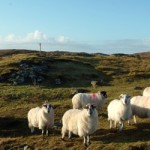The largest charity organisation dedicated to the protection of Scottish wildlife has called for starving deer to be culled across Scotland.
Calling for an extension of the stalking season of female deer which ended earlier last month (15 February) in line with current legislation (Deer (Scotland) Act 1996), the Scottish Wildlife Trust (SWT) today claimed that culling starving animals which are battling to survive through harsh winter conditions, would prevent inhumane suffering as well as helping to halt further damage to Scotland’s environment.
Simon Milne, SWT’s Chief Executive, explained: “We are a wildlife protection charity calling for more deer to be culled. I understand that this might surprise some people, but our reasoning is sound. Red deer numbers have been steadily increasing in recent decades to the point where, in some areas, they are causing damage to the natural environment. The most obvious impact is on young trees that have little chance of growing into the forests of future when large numbers of deer are browsing for food.
“As the harsh winter weather continues, some wildlife species are struggling to cope. Red deer are facing a double whammy – they were already stressed because too many animals were competing for limited food resources and now they are being subjected to a long and cold winter. Our deer are ill-equipped to deal with prolonged winters because, by and large, they are living in conditions that do not suit them. Red deer are really a woodland species and the now treeless environment of many parts of Scotland simply does not satisfy their basic need for shelter, particularly in bad weather. Too many deer and not enough food is resulting in starvation.
“In parts of Scotland large numbers of deer can currently be seen gathered at roadsides pawing the snow in an attempt to uncover the frozen vegetation . Rapidly losing condition due to exposure and lack of food many will slowly starve to death. Extending the culling season means that stalkers can continue to shoot any deer that are suffering or too weak to survive until the spring.
“There is no quick fix to this problem, in fact it will take decades to achieve a balanced deer population. Deer numbers must be reduced in many areas to a sustainable level which is a difficult, time consuming and expensive business. The regeneration of our native highland woodland is a priority and requires a massive, sustained and long term effort to achieve; then we might start to see red deer living as they are meant to, as healthy forest animals. The SWT hopes these are problems which will be addressed in the forthcoming Wildlife and Natural Environment Bill.”
Deer populations in Scotland have reached an unsustainably high level due to the absence of any natural predators. Scotland is home to two native deer species, the red deer and the roe deer. Together it is thought there are over 350,000 deer inhabiting Scotland today, around twice the population of half a century ago.
Hebrides Today brings you the latest news from the Western Isles
.


 Welcome
Welcome Hebrides airport passenger figures down
Hebrides airport passenger figures down Western Isles MSP speaks on crofting reform bill
Western Isles MSP speaks on crofting reform bill Firefighter radio system goes live
Firefighter radio system goes live Scottish fishermen lay down challenge to new government
Scottish fishermen lay down challenge to new government